Stamps Stories
![]()

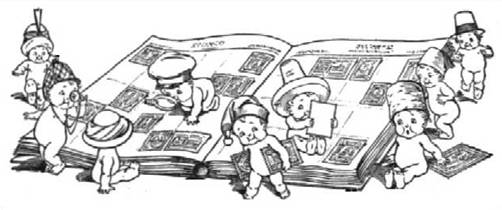
![]()
A
young collector asked an old advanced philatelist how he made his collection so
advanced and valuable.
The old guy had a look at the young nuisance and said, "Well, young man, it was in 1940 when I got a bunch of old letters from an uncle, I soaked off the stamps, dried them and put them in a presentation folder. I spent four days on this, after which I sold the stamps at my school for a cool 4 dollars.
"The
next morning, I invested those four dollars in some more stamps on paper. I
spent the next four days on them and sold them afterwards for 6 dollars. I
continued this system for a month, by the end of which I'd accumulated a
fortune of 200 dollars.
"Then
my uncle died and left me his collection worth two million dollars..."
The World's Smallest
Stamp
(source:
Stampworld)
We
all know that stamps come in various shapes and sizes, but do you know exactly
how diverse they are? This week we are focusing on one particular trait, as we
are looking for the smallest stamp ever issued for actual postage.
The
search for the world's smallest stamp takes us back to a time before Ford had
produced the first Model T. Actually we have to go all the way back to the
Battle of Gettysberg to find the smallest postage
stamp ever issued.
In
1863, the first stamp was issued by Bolivar - one of the 9 states in the United
States of Colombia. The state was formed as part of the United States of
Colombia earlier in 1863, after the civil war in 1860-1862.
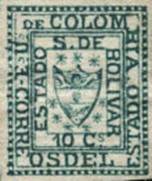
The
first stamp issued by Bolivar, is the one shown here. It carries the Coat of
Arms of Bolivar, with stars traced around the Coat of Arms. The stamp exists in
two versions - a version with 6 stars below, as shown here, and a version with
5 stars below. Both versions are rare, with the 5 star version carrying the
highest catalogue value.
The
stamp doesn't look particularly special as seen here, but what makes the stamp
special is the size - this stamp is no more than 8mm x 9.5mm in size, which is
exceptionally small! A standard American stamp is 22.10mm x 24.89mm, which
should give an idea of just how small this stamp must be.
In the South American countries of
http://www.mysticstamp.com/content.asp?contentID=36
See also “Stamped
with Blood” - http://www.thescreamonline.com/essays/essays3-2/stamped/stamped.html
South Korea's first stamp of the year 2004 was
angering Japan. It features an island claimed by both countries, called
"Takeshima" in Japan and "Tok-do" or "Dokdo" in
South Korea.
It's
uninhabited, but surrounded by fertile fishing grounds. Both countries have
claimed it since Korea was liberated from Japanese colonial rule in 1945.
The South Korean postal service plans to begin
selling a set of four stamps titled "The Nature of Tok-do" on Jan. 16
2004 picturing birds and flowers native to the island.
There was a demonstration in support of the
stamps in front of the Japanese embassy in Seoul. Japan's Public Management
Ministry sent a letter in September asking South Korean postal authorities to
"reconsider" the plan, and the Foreign Ministry repeated the request
through diplomatic channels in December, the Asahi newspaper reported.
Japan says portraying the disputed island on
stamps violates the spirit of the Universal Postal Union, which aims for
international cooperation, the reports said.
Here are details on the stamps, from the Korea
Post Web site:
Surrounded by the sea on three sides, the
territorial reach of Korea includes more than 3,400 islands of all shapes and
sizes. This series of stamps featuring the ecological system of the islands
promotes public awareness of the significance of preserving these islands.
Introduced in the first of the series is the nature of Dokdo Island.
Making their home on the
Most of these plants are short as an adaptation
to withstand the gusty sea winds and the leaves are generally thick and covered
with fine hairs for protection against the cold. The island's many steep slopes
causes the rainfall to run off into the ocean quickly resulting in a deficiency
of moisture and soil that is relatively poor in nutrients. Thus, the number and
variety of wild plants on the island is limited. From May to June, Dokdo is
covered with Calystegia soldanella R. Brown that bloom pink flowers while in
September, light purplish flowers of Aster spathulifolius Maxim. var. oharai
(Nakai) Y. Lee enrich the scenery of the island.
Every year from spring to summer, Black-tailed
Gulls, Streaked Shearwaters and Swinhoe's Storm Petrels breed on the island.
During the migration season, such migratory birds as Red-necked Phalaropes,
Ospreys, Dusky Thrushes, and Gray-tailed Tattlers pass through the island. The
breeding ground has been designated as Natural Monument No. 336 and is
protected as the 'breeding site for the sea birds of Dokdo'. Black-tailed
gulls, a permanent resident of Korea, which can be easily spotted on the
seashores around the nation, flies to Dokdo every May. Streaked shearwaters and
swinhoe's fork-tailed Petrels, both sea birds, lay one egg after digging a hole
in the crevices of the rocks or on the soil on isolated islands of Korea. These
summer migratory birds leave for Southeast Asia in the fall.
http://www.virtualstampclub.com/korea_japan.html#_blank
The world’s longest-lived mail delivery system
exists to this day in India. Called the Dak or Dawk system, this organization
can be traced back to Roman relay runners. Dak runners carried the mail
over long distances by inserting it in a stick, split down the middle. A torch
bearer helped guide the runners at night, and another ran along beating a drum
to scare off dangerous animals. Sometime during the seventeenth century,
the job of carrying the torch and tom-tom were combined. The East India Company
ran the system while Britain controlled India. During that time, postal
inspectors were employed, and time keepers kept the runners on schedule.
http://www.mysticstamp.com/content.asp?contentID=36
Sod House
Around
1898 John McCarthy, a frontier photographer, took a picture of John and Marget
Bakken's sod house near Milton, North Dakota. The picture includes the Bakken's
children, Tilda and Eddie, and a small dog (under the window of the sod house).
Click to enlarge
The Homestead
Act commemorative stamp, based on the John McCarthy
photograph, was released at Beatrice, Nebraska on May 20, 1962.
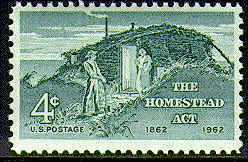
United States Scott #1198
The
picture also was used by Norway on its 1975 postage stamp commemorating the
sesquicentennial of Norwegian emigration to America. Even the dog made it to
the stamp!

Norway Scott #658-659
http://memory.loc.gov/ammem/today/may20.html http://www.danstopicals.com/sodhouse.htm
The first recorded stamp collector was John Bourke, who served as Receiver-General of Stamp Duties in Ireland.
http://www.mysticstamp.com/content.asp?contentID=36
Dr. John Edward Gray of the British Museum
became the first collector of adhesive stamps when he purchased a block of
Penny Blacks on May 1, 1840.
http://www.mysticstamp.com/content.asp?contentID=36
The January 1, 1869 issue of Stamp Collectors Magazine showed collectors how to make their own stamp hinges cut from the margins of stamp sheets. This is the first known example – previously collectors had pasted their stamps directly into their albums. http://www.mysticstamp.com/content.asp?contentID=36
Gokstad Ship
In
The
stamp shows an artist's impression of the Gokstad ship in the style of the
Bayeux Tapestry, with a dragon's head on the prow.
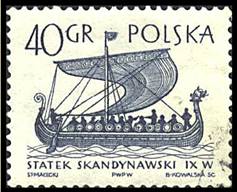
The Columbian
Exposition was held in
The name “Leif
Ericson” was rejected as too controversial for the Columbian Exposition, so the
name was changed to “Viking.” It sailed from Bergen on April 30, 1893, and
arrived on June 13, 1893 at New London, Connecticut (44 days). It was displayed
at the Columbian Exposition, and then donated to the city of Chicago, where it
exhibited to the public until 1993.
In 1925 to publicize
and promote the Norse American Centennial in St. Paul a set of two stamps was
issued, one of them bearing a picture based on the Gokstad replica, “Viking.”
taken from a photograph. The engravers even included the American flag waving
from the bow, as it was on the replica.
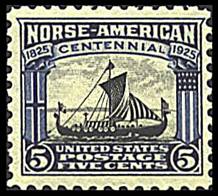
http://www.danstopicals.com/gokstad.htm
In 1918, the British government counterfeited
stamps from the nations of Austria, Bavaria and Germany. The stamps were
then to be used to mail fake propaganda leaflets and postcards to neutral
countries, such as Switzerland or Holland, who would believe they were the
genuine articles. It was hoped these letters would win support for the
Allies, but the program was abandoned before it could be employed.
However, during WW II the British did successfully circulate German
"Hitler Head" stamps. These stamps were used to spread rumors
of dissension among German Army troops.
http://www.mysticstamp.com/content.asp?contentID=36
George Herpin of Paris, a French stamp fancier
back in the 1860s, when stamps were a fairly new invention, was the first to
use the term philately. Herpin didn’t like the term
"timbromanie," which means stamp madness, which had been popular in
the 1860s.
Before stamps, the recipient of a letter, not
the sender, had to pay the postage. Stamps forced the sender to foot the bill,
and created a lot of stamp lovers among folks on the receiving end of the
mail-and a mania for stamp collecting.
"Timbromania" from the French word
"timbre" for stamp- which means stamp madness, was toyed with
as a term to affix to this new hobby.
But when Herpin suggested
"philatélie" (anglicized to "philately"), combining the
Greek root "phil-," meaning "loving," with Greek
"ateleia," meaning "tax-exemption,".
http://www.mysticstamp.com/content.asp?contentID=36, http://www.persiphila.com/whatsnu1.htm
A collection is like a puzzle: if you have one
hundred separate pieces they don't mean anything, It's only when they are put
into a context that they tell a story.
- René Beyer - (http://filatelist.tripod.com/quote.html)
The collector is never finished. You're always
looking for anything you don't have that will improve the collection, It's a
hobby without end ... for once you decide your collection is complete, you can
no longer call yourself a collector.
- Philippe Stern - (http://filatelist.tripod.com/quote.html)
You could not own this "gem" forever. No matter
for how long you own it, you are merely a temporary holder of this
"gem". What really matters is how would you appreciate, enjoy and
utilize it while you own it.
- I.M. Chait - (http://filatelist.tripod.com/quote.html)
http://www.themysterybox.com/StampWhys/index.html
Links
Stamps
Facts http://www.stamp2.com/library/facts/site/default.asp

![]()


